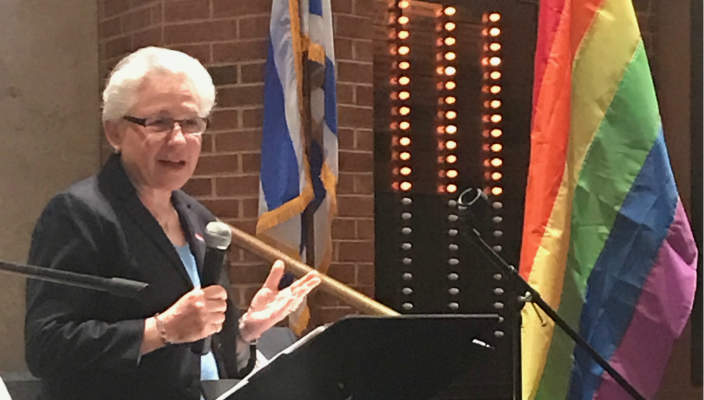
In 2018, Reform Congregation Keneseth Israel (KI) in Elkins Park, PA, hosted its first Pride Shabbat, and to enhance the service that evening, our cantor purchased and displayed a rainbow flag below the bimah (the platform from which services are conducted). As one of the speakers, I described the dangers of living a life in the closet, and as I concluded my remarks, I walked over to the flag, put my arms around it, and said I was happy to see it inside my own synagogue.
Several weeks later I was dismayed to see the flag was gone. I eventually found it in the corner of the coat closet, but I was even more dismayed that my request to return it to its place near the bimah was refused because, according to one of the congregation’s lay leaders, it was unclear whether or not the community would accept the presence of the rainbow flag on a permanent basis.
I was baffled by this response for two reasons: KI prides itself on inclusion, and our website states that KI “embrace[s] the full participation…of LGBTQ individuals.” Also, LGBTQIA+ inclusion has been part of the Union for Reform Judaism’s platform for more than three decades.
Why, I asked, was the flag so hard to accept? I suggested it could be placed in the lobby, away from the bimah. The lay leader stood fast, and I was surprised to hear that rejection echoed by others.
A formal process for me to follow was outlined that included speaking with four groups within the congregation’s lay leadership: the social justice committee, the inclusion committee, the board of trustees, and the board of directors, a smaller group among the trustees that serves as the decision-making body for the congregation. I was surprised to meet resistance from some trustees who felt that flags belong only to nations; others felt that LGBTQIA+ displays were “unnecessary” because we were already doing enough. Although at times, this process felt long and onerous, it led to a fruitful, open conversation.
As the discussions continued, someone suggested we put the rainbow symbol on the banner in our lobby that already included the word “Community” to denote that LGBTQ+ individuals and families are welcomed within our community. Not bad, I thought. Next came the suggestion that the rainbow could appear on our literature, as a new way to brand our synagogue. Then came the suggestion that we could put the rainbow symbol on our front door. I thought these suggestions would result in a more powerful display of LGBTQ inclusion than just the flag, so I supported these changes in lieu of displaying the flag.
Amidst this formal process of lobbying for a visual display of LGBTQIA+ inclusion, an informal process also was unfolding as the result of an email chain begun by a member who is a straight ally. Writing to a group of members, she said; “I want to encourage KI to place the rainbow flag in full view as have a number of churches, the British Museum, and even Parliament. If you agree, I hope you will speak up and out.”
The postings were lively, heartfelt, at times emotional, and supportive. Some congregational leaders disliked this informal process and criticized it publicly and privately for operating outside the formal structure. I found it to be important for two reasons: first, it demonstrated the informal support within the synagogue, and second, it gave people without a formal voice the opportunity to express their position on an important debate taking place in our synagogue. People learned from one another about how LGBTQIA+ people could feel excluded, though that was never the intent of the congregation. They learned how to become allies to LGBTQIA+ members and their families.
In the end, every formal committee approved displaying the rainbow symbol. We quickly affixed our initials, “KI,” over the rainbow colors on the glass of our front doors and our cantor posted a photo of herself pointing to the new logo on her Facebook page. With some trepidation, I watched her page. In all she received 292 “likes” plus 21 positive comments.
In the past year, KI rainbow magnets have been spotted on congregants’ cars and on the doors of our preschool and religious school. The new logo appears on our website and publications. The flag reappeared for our second pride Shabbat this year, and it was great to see it. By working together as a community, we achieved a greater outcome for LGBTQIA+ inclusion at KI. If we had simply put the flag on the bimah we would have missed the opportunity to learn from and support one another. Most important, we transformed our display of welcoming from a flag positioned inside our synagogue to logos that face out to the community.
Have something to say about this post? Join the conversation in The Tent, the communications and collaboration platform for congregational leaders of the Reform Movement. You can also tweet us or tell us how you feel on Facebook.
Related Posts

Congregational Consulting Cohorts: Addressing Challenges Together

Enhance Meeting Effectiveness with Our New Toolkit

